How to Reset Your Samsung Refrigerator: Your Complete Guide
In the hustle and bustle of everyday life, a refrigerator can often be taken for granted—until something goes wrong. Whether your Samsung refrigerator is displaying an error code, not cooling effectively, or simply behaving sluggishly, you might consider performing a reset. In this article, we'll explore when and how to reset your Samsung refrigerator, along with useful insights into maintaining optimal performance. Resetting may seem daunting, but with the right approach, it can be a straightforward task that empowers you to tackle minor issues yourself.
🤔 Why Reset Your Samsung Refrigerator?
Before delving into the process of resetting, it's essential to understand why a reset might be necessary. Resetting your fridge can resolve minor glitches, update connections, and clear bugs. Here are some common reasons you may need to reset:
- Error Codes: Your refrigerator might display error codes indicating an internal issue, which can often be resolved with a reset.
- Cooling Issues: If the refrigerator or freezer isn't cooling properly, a reset might help re-calibrate the system.
- Unresponsive Display: Sometimes, the digital display can freeze or become unresponsive.
- Ice Maker Malfunction: Issues with the ice maker operation might be corrected with a system reset.
When Not to Reset
While resetting is a handy tool, it’s not a cure-all. Persistent issues such as strange noises, leaks, or continued cooling failures might require professional assessment.
🔧 How to Reset Your Samsung Refrigerator
Let's get started with a simple reset that can often alleviate common problems. These steps should guide you through the reset process for most Samsung models.
Step-by-Step Reset Process
Check the Manual: First, consult your model's user manual for specific instructions related to your refrigerator model.
Power Cycle Method:
- Turn it Off: Locate the power button or unplug the refrigerator from the outlet.
- Wait: Leave it powered off for about 5 to 10 minutes to let any residual power dissipate.
- Turn it On: Plug it back in or switch the power back on.
Using the Control Panel:
- Press and Hold Buttons: Commonly, pressing two buttons on the control panel simultaneously—such as ‘Power Cool’ and ‘Power Freeze’—for a few seconds will initiate a reset.
- Listen for a Beep: In many models, a beep indicates that the reset process is underway.
Reset Button:
- Some models have a reset button on the inside or behind the control panel. Consult your user manual to locate it.
⚠️ Important Tip
- Power Surge Precautions: If the power has been interrupted recently, perform a reset after ensuring stable power to prevent future issues.
What to Do After Resetting
- Monitor the Performance: Check if the refrigerator resumes normal function.
- Check Error Codes: Ensure error codes are cleared.
- Observe Temperature Settings: Reset them if necessary, as some settings may revert to default.
- Recalibrate the Ice Maker: If your fridge supports this, recalibrate the ice maker by running a test cycle.
📘 Understanding Your Refrigerator’s Control Panel
The control panel of a Samsung refrigerator is a crucial component for managing settings and diagnosing issues. Familiarizing yourself with its function can improve your troubleshooting prowess.
Common Control Panel Features
Temperature Settings: Allows you to manually alter the internal temperature settings for both the fridge and freezer compartments.
Power Freeze and Power Cool Functions: Accelerates the cooling process but should be used sparingly to save energy.
Ice Maker Controls: Features for turning the ice maker on or off, or selecting ice cube size.
Error Code Display: Quickly identifies issues; use the user manual to decode errors.
📊 Summary of Reset Steps
Here’s a handy summary to keep your reset procedure streamlined:
| Step | Action | Note |
|---|---|---|
| 1. Power Cycle | Turn off, wait, turn on | Helps with temporary glitches |
| 2. Control Panel | Press and hold appropriate buttons | Use 'Power Cool' + 'Power Freeze' or similar |
| 3. Reset Button | Locate and press if available | Refer to the user manual |
| 4. Post-Reset | Monitor, check codes, recalibrate | Ensure stable operation and settings restoration |
🛠️ Practical Tips for Maintenance
Keeping your Samsung refrigerator in prime condition can reduce the need for frequent resets. Here are some maintenance tips:
- Regular Cleaning: Clean the interior and exterior regularly to prevent the buildup of grime and dust.
- Keep Vents Clear: Ensure that air vents inside aren’t blocked by food items.
- Door Seals: Check that seals and gaskets are clean and intact to maintain efficient cooling.
- Temperature Settings: Keep the temperature at recommended settings for energy efficiency and food preservation.
- Professional Servicing: Schedule professional checks annually to prevent bigger issues over time.
🚀 Final Thoughts
Now that you know how to reset your Samsung refrigerator, you're equipped with a valuable tool for addressing minor technical issues. While resets are useful, remember they are just one part of maintaining optimal refrigerator health. By staying informed and proactive, you can ensure your refrigerator remains a reliable and efficient part of your household.
Feel free to print this guide or save it for future reference as a quick troubleshooting resource. And if challenges persist, consulting a professional technician can provide peace of mind and a long-term solution. Here's to a smooth-running kitchen appliance experience!
